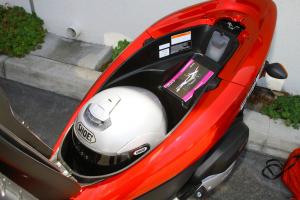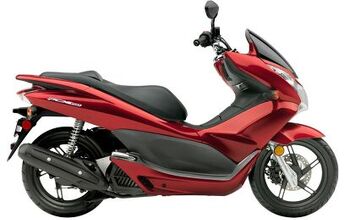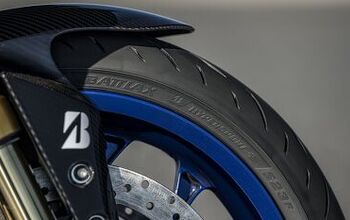2013 Honda PCX150 Review - Motorcycle.com
After testing the Honda PCX during our 2012 125cc Scooter Shootout, I thought the PCX was, for me, the perfect scooter. With its European looks, spacious underseat storage, impressive performance and fuel economy, for a brief moment I actually thought about – gasp – buying one for my personal stable. But there was one problem: at only 125cc, it wasn’t highway legal. And, living in Southern California, we live and die by the highway system.
Now, with the new and improved Honda PCX150, Team Red has directly addressed this issue, boring out the original 125cc, two-valve, programmed fuel-injected engine to 152.9cc, making it officially eligible to hop on the freeway. Of course, being a Honda, while the 125 engine was getting a facelift, engineers made other improvements as well.
A number of subtle improvements to the cylinder and rocker arm reduce friction, while the piston itself went on a diet, thanks to CAE (Computer Aided Engineering) analysis. A more efficient radiator allows the use of a smaller, lighter cooling fan, and internal modifications reduce oil agitation losses, allowing oil capacity to come down approximately 25% compared to the 125cc version.
All of these low-friction, higher-efficiency adoptions are a reflection of a global initiative Honda calls ESP, or Enhanced Smart Power. ESP’s aim is to develop environmentally responsible scooter engines without compromising performance. Further proof of this initiative is the 150’s “built-in” cooling system.
Whereas other scooters place their radiators near the nose or head of the leg shield, requiring complex hose routing, the PCX150’s radiator is placed directly adjacent of the engine, toward the center of its crank axis. This reduces and simplifies cooling system parts, with an added benefit of centralizing weight. Revised gearing results in more oomph when launching from a stop.
Honda claims this world-model scoot will achieve 102 mpg, but it’s interesting to note, in the interest of keeping costs down, the units coming to this side of the pond won’t be equipped with the Idle Stop feature, which shuts down the engine at a stop to conserve fuel. This technology becoming more prevalent in the car world.
Other changes: seat cushions use a different material for firmer support, and a new mounting bracket is available to accept an accessory 35-liter top box in case the 25-liter underseat storage and additional 1.5-liter front storage compartment weren’t enough.
Otherwise, the PCX150 remains largely unchanged from its 125cc predecessor. The Honda V-Matic CVT eliminates the need to shift, while a 31mm conventional fork and single shock, offering 3.5 and 3.1 inches of travel, respectively, handle suspension duties. Even styling cues have gone unchanged, still fresh and attractive with its angular, Euro-inspired lines. Bringing the scoot to a stop is a rear drum and single 220mm front disc mated to a three-piston caliper. Honda’s Combined Braking System links rear to front, but not front to rear.
At first glance, it’s easy to mistake the PCX150 for its smaller predecessor. Pick it up off the sidestand or centerstand and this feeling continues even from the saddle, as the user interface has gone unchanged. Thumb the starter and the PCX quietly purrs to life like before. The difference is felt once you twist the throttle, as the extra muscle (relatively speaking) noticeably propels the PCX off the line with just a smidge more urgency than the 125cc model. Performance easily trumps anything in the 125 category, and will likely give fits to bigger competition as well.
And being fuel-injected, there’s no worry about waiting for it to warm up. Simply start it and ride away. There’s plenty of squirt to maintain pace with surrounding traffic, though when it comes time to hop on the freeway and reach merging speed, the urgency in its acceleration quickly drops.
I was able to reach an indicated 70 mph before the little scoot plateaued. It wasn’t having any more. Ride quality is supple and compliant, though suspension damping feels more on the firmer side than I remember from the 125. The 90/90-14 front, 100/90-14 rear tires remain unchanged.
Apart from the extra grunt from the engine and perceived firmness in the suspension, it was difficult to notice much of a change between new and old. Mainly because there’s not much of one. My 5-foot, 8-inch frame fits nicely in the 29.9-inch high saddle with convenient support from the backrest. Taller riders may want to remove this backrest for a greater breadth of seating positions. Swooping floorboards allow riders to place their feet directly below them or out in front, cruiser style.
With its mass-centralized engine and fuel tank, the bulk of the PCX150’s claimed 286-pound curb weight is low in the chassis, allowing for quick, neutral handling despite its 27.0-degree rake. With its linked brakes, slowing down was never an issue. The front binder scrubs speed just fine for 90% of applications, though using both brakes makes a noticeable difference during emergency stops.
When viewed from a performance and intended design standpoint, the PCX150 is hard to top. With room for a full-face helmet (and then some) under the seat, responsive yet supportive handling, and a freeway-legal, fuel-injected engine, what more could you ask for? Judging from our past experience, Honda’s claim of 102 mpg is hard to believe, but we’ll have to wait until we can get one for a thorough test to find out. Still, expect impressive mileage numbers.
Honda says the mid-displacement scooter category is the second-most popular behind the 50cc category, with 66% of sales going to first-time scooter buyers. Interestingly, 20% of these consumers are brand new to two-wheels and 33% are women. At $3,449, it’s difficult to think of a more capable performer for the price.
Hell, maybe I’ll actually end up buying one this time.
Related Reading
2013 Vespa LX and S 125/150 3V Review
2012 Piaggio X10 350 Review
2012 Honda Metropolitan Review
2012 125cc Scooter Shootout - Video
2012 Yamaha Zuma 125 Review
2012 Piaggio Typhoon 125 Review
2012 Yamaha Zuma 50F Review - Video
2012 Kymco Scooter Lineup Review
2011 Honda PCX Review
More by Troy Siahaan


































Comments
Join the conversation